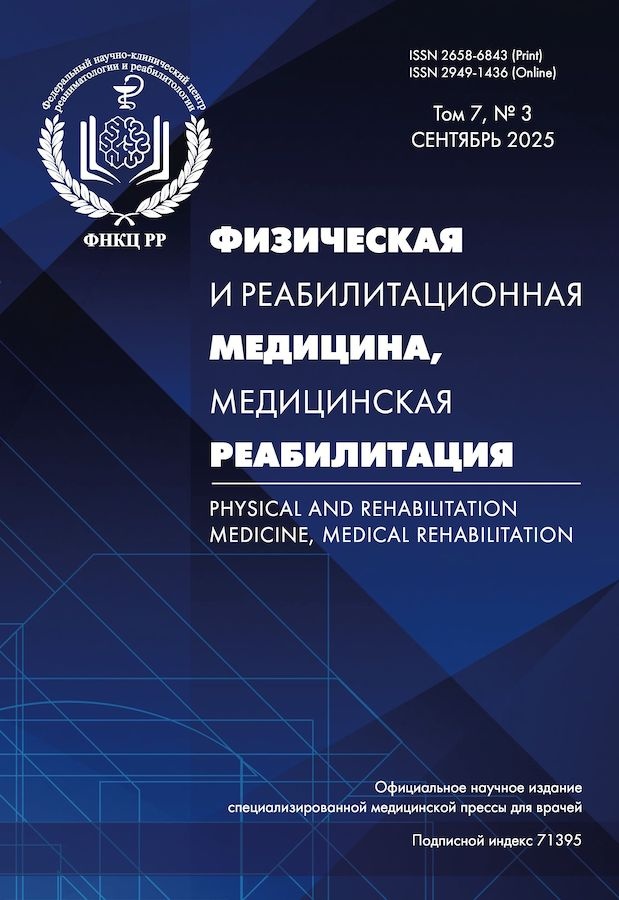Quality assessment in medical rehabilitation
- Authors: Lutsky L.1, Treger I.2
-
Affiliations:
- South Department of Clalit Health Services, Rehabilitation Unit
- Soroka University Medical Center, Rehabilitation
- Issue: Vol 2, No 1 (2020)
- Pages: 39-48
- Section: REVIEWS
- URL: https://journal-vniispk.ru/2658-6843/article/view/19266
- DOI: https://doi.org/10.36425/rehab19266
- ID: 19266
Cite item
Full Text
Abstract
The advances of modern medicine, prolonging the average life-span, and especially the recognition of medical rehabilitation as a vital part of the medical process, have created rapid development in the field among most of the countries worldwide. The dynamic process of the development in the fields of medical rehabilitation in Russian healthcare, has brought up questions about different outlooks, principles and processes of quality assessment in medical rehabilitation. Taking into consideration the differences in the organizational structures and professional tendencies — applying the indicators of quality into rehabilitation practice can prove to be challenging. In the last years the Israeli health system has gained much experience working with different rehabilitation structures. The Obligatory State Insurance of the Israeli health system forced Health Funds to developed optimal indicators for the evaluation of the professional quality in rehabilitation. The accumulated knowledge can help in creating a system for the quality assessment in Russian Federation. Rehabilitation is characterized by a long list of professional performance aspects which are exposed to quality control. That is why it is common to define indicators separately for the structures, processes, and results. In different countries dissimilar aspect of quality are defined as indicators, but all of them are built on similar principles — which focus on the simplicity and objectiveness of information gathering, minimal dependency on the character of the auditor, combining different forms of internal and external examination, and including systems of quality control by gathering questionnaires from the patients and their family members. The chosen quality indicators of the rehabilitation process need to reflect on the different sides of the professional treatment, stimulating a constant increase in quality on account of organizational activities in the industry in general and in separate departments in particular. The International Classification of Functioning (ICF) is widespread over many countries and constitutes the accepted paradigm in the field of medical rehabilitation, and with time may become the optimal platform for developing a system of quality control worldwide.
Full Text
##article.viewOnOriginalSite##About the authors
L. Lutsky
South Department of Clalit Health Services, Rehabilitation Unit
Email: treiuly@yandex.ru
MD, MHA
Israel, Beer ShevaI. Treger
Soroka University Medical Center, Rehabilitation
Author for correspondence.
Email: treiuly@yandex.ru
MD, PhD, MHA
Israel, Beer ShevaReferences
- Treger I, Lutsky L. Tendencies in development of medical rehabilitation, from past to future. Physical and rehabilitation medicine, medical rehabilitation. 2019;1(2):101–106. doi: 10.36425/2658-6843-19194.
- Трегер Ю., Луцки Л. Амбулаторная реабилитация (обзор литературы и Израильский опыт) // Вестник восстановительной медицины. — 2014. — № 5. — С. 95–100. [Treger Yu, Lutski L. Outpatient rehabilitation (literature review and the Israeli experience). Vestnik vosstanovitel’noy meditsiny. 2014;(5):95–100. (In Russ).]
- Stucki G, Bickenbach J, Gutenbrunner C, Melvin J. Rehabilitation: the health strategy of the 21st century. J Rehabil Med. 2018;50(4):309–316. doi: 10.2340/16501977-2200.
- Кузякина А.С., Купрейчик В.Л., Богатырев А.Д., и др. Медицинская реабилитация в рамках дневного стационара // Вестник восстановительной медицины. — 2017. — № 6. — С. 21–27. [Kuzyakina AS, Kupreychick VL, Bogatirev AD, et al. Outpatient medical rehabilitation. Vestnik vosstanovitel’noy meditsiny. 2017;(6):21–27. (In Russ).]
- Bin Nun G. Private health insurance policies in Israel: a report on the 2012 Dead Sea Conference. J Health Policy Res. 2013;2(1):25. doi: 10.1186/2045-4015-2-25.
- Rosen B, Merkur S. Israel: Health system review. Health Systems Transition. 2009;11(2):1–226.
- Иванова Г.Е., Мельникова Е.В., Шмонин А.А., и др. Пилотный проект «Развитие системы Медицинской Реабилитации в Российской Федерации». Протокол второй фазы // Ученые записки Санкт-Петербургского государственного медицинского университета имени академика И.П. Павлова. — 2016. — Т. 23. — № 2. — С. 27–34. [Ivanova GE, Melnikova EV, Shmonin AA, et al. Pilot project “Development of medical rehabilitation system in Russian Federation”. Protocol of second stage. Scientific notes of the I. P. Pavlov St. Petersburg State Medical University. 2016;23(2):27–34. (In Russ).]
- Приказ Министерства труда и социальной защиты Российской Федерации от 03.09.2018 № 572н «Об утверждении профессионального стандарта «Специалист по медицинской реабилитации»». [Order of the Ministry of labor and social protection of the Russian Federation No. 572n «Ob utverzhdenii professional’nogo standarta “Spetsialist po meditsinskoy reabilitatsii””; dated 03.09.2018. (In Russ).] Доступно по: http://publication.pravo.gov.ru/Document/View/0001201809200018. Ссылка активна на 15.12.2019.
- Donabedian A. The quality of care: how can it be assessed? JAMA. 1988;260(12):1743–1748. doi: 10.1001/jama.260.12.1743.
- Dowla N, Chan L. Improving quality in stroke rehabilitation. Top Stroke Rehabil. 2010;17(4):230–238. doi: 10.1310/ tsr1704-230.
- Eldar R. Quality of care in rehabilitation medicine. Int J Qual Health Care. 1999;11(1):73–79. doi: 10.1093/intqhc/ 11.1.73.
- Hoenig H, Lee J, Stineman M. Conceptual overview of frameworks for measuring quality in rehabilitation. Top Stroke Rehabil. 2010;17(4):239–251. doi: 10.1310/tsr1704-239.
- Winstein CJ, Stein J, Arena R, et al. Guidelines for adult stroke rehabilitation and recovery: a guideline for healthcare professionals from the American Heart Association / American Stroke Association. Stroke. 2016;47(6):98–169. doi: 10.1161/STR.0000000000000098.
- Ring H, Itzkovich M, Dynia A. Survey on the use of function assessment and outcome measures in rehabilitation facilities in Israel (SUFA 2004). Isr Med Assoc J. 2007; 9(2):102–106.
- Shaw C. How can hospital performance be measured and monitored? Copenhagen, WHO Regional Office for Europe; 2003. Available from: http://www.euro.who.int/document/e82975.pdf.
- Jackson K, Hamilton S, Jones S, Barr S. Patient reported experiences of using community rehabilitation and/or support services whilst living with a long-term neurological condition: a qualitative systematic review and meta-aggregation. Disabil Rehabil. 2019;41(23):2731–2749. doi: 10.1080/09638288.2018.1473508.
- Novak C, Yuson M. Tips for effective auditing/monitoring of medicare documentation for OT, PT and Speech. Kaiser Permanente; 2013. Available from: https://www.hcca-info.org/Portals/0/PDFs/Resources/Conference_Handouts/Compliance_Institute/2013/POST/POSTAM16print1.pdf.
- Rehabilitation management systems audit tool. Version 1.3. Australian Government Comcare; 2017. Available from: https://www.comcare.gov.au/__data/assets/pdf_file/0011/ 136100/04781_SM_RMS_audit_tool_v2.pdf.
- Medina-Mirapeix F, Jimeno-Serrano FJ, Escolar-Reina P, Del Baño-Aledo ME. Is patient satisfaction and perceived service quality with musculoskeletal rehabilitation determined by patient experiences? Clin Rehabil. 2013;27(6): 555–564. doi: 10.1177/0269215512468142.
- Ring H, Feder M, Schwartz J, Samuels G. Functional measures of first-stroke rehabilitation inpatients: usefulness of the functional independence measure total score with a clinical rationale. Arch Phys Med Rehabil. 1997;78(6): 630–635. doi: 10.1016/s0003-9993(97)90429-9.
- Moore JL, Potter K, Blankshain K, et al. A core set of outcome measures for adults with neurologic conditions undergoing rehabilitation. J Neurol Phys Ther. 2018;42(3):174–220. doi: 10.1097/NPT.0000000000000229.
- Rivara FP, Ennis SK, Mangione-Smith R. Quality of care indicators for the rehabilitation of children with traumatic brain injury. Arch Phys Med Rehabil. 2012;93(3):381–385. doi: 10.1016/j.apmr.2011.08.015.
- Cameron ID, Dyer SM, Panagoda CE, et al. Interventions for preventing falls in older people in care facilities and hospitals. Cochrane Database Syst Rev. 2018;9(9):CD005465. doi: 10.1002/14651858.CD005465.pub4.
- Inpatient rehabilitation facility services. Chapter 10. Report to the Congress. Medicare Payment Policy; |2018. Р. 267–294. Available from: http://www.medpac.gov/docs/default-source/reports/mar18_medpac_ch10_sec.pdf?sfvrsn=0.
- Zucker I, Laxer I, Rasooli I, et al. Regional gaps in the provision of inpatient rehabilitation services for the elderly in Israel: Results of a national survey. Isr J of Health Policy Res 2013;2:27. doi: 10.1186/2045-4015-2-27.
- Truchon C, Fallah N, Santos A, et al. Impact of therapy on recovery during rehabilitation in patients with traumatic spinal cord injury. J Neurotrauma. 2017;34(20):2901–2909. doi: 10.1089/neu.2016.4932.
- Jesus TS, Hoenig H. Postacute rehabilitation quality of care: toward a shared conceptual framework. Arch Phys Med Rehabil. 2015;96(5):960–969. doi: 10.1016/ j.apmr.2014.12.007.
- Zorowitz RD. Stroke rehabilitation quality indicators: raising the bar in the inpatient rehabilitation facility. Top Stroke Rehabil. 2010;17(4):294–304. doi: 10.1310/tsr1704-294.
- Inpatient rehabilitation facility quality reporting program: specifications for the quality measures proposed through the fiscal year 2016 notice of proposed rulemaking. RTI International is a trade name of Research Triangle Institute; 2015. Available from: https://www.cms.gov/Medicare/Quality-Initiatives-Patient-Assessment-Instruments/IRF-Quality-Reporting/Downloads/Inpatient-Rehabilitation-Facility-Quality-Reporting-Program-Specifications-for-the-Quality-Measures-Proposed-Through-the-Fiscal-Year-2016-Notice-of-Proposed-Rulemaking-report.pdf.
- Kramer A, Lin M, Fish R, Min SJ. Development of inpatient rehabilitation facility quality measures: potentially avoidable readmissions, community discharge, and functional improvement. Providigm, LLC; 2015. Available from: http://www.medpac.gov/docs/default-source/contractor-reports/ development-of-inpatient-rehabilitation-facility-quality-measures-potentially-avoidable-readmissions.pdf?sfvrsn=0.
- Wang H, Niewczyk P, Divita M, et al. Impact of pressure ulcers on outcomes in inpatient rehabilitation facilities. Am J Phys Med Rehabi. 2014;93(3):207–216. doi: 10.1097/PHM.0b013e3182a92b9c.
- Sherrington C, Lord SR, Close JC, et al. Development of a tool for prediction of falls in rehabilitation settings (Predict_FIRST): a prospective cohort study. J Rehabil Med. 2010;42(5):482–488. doi: 10.2340/16501977-0550.
- Naylor MD, Aiken LH, Kurtzman ET, et al. The care span: the importance of transitional care in achieving health reform. Health Aff (Millwood). 2011;30(4):746–754. doi: 10.1377/hlthaff.2011.0041.
- Jesus TS, Hoenig H. Postacute rehabilitation quality of care: toward a shared conceptual framework. Arch Phys Med Rehabil. 2015;96(5):960–969. doi: 10.1016/ j.apmr.2014.12.007.
Supplementary files








